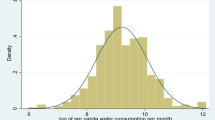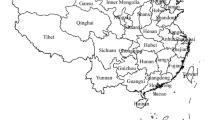Abstract
This study utilizes a threefold empirical analysis in order to examine the relationship between income and water equity in Bulgaria, the fastest shrinking country in the world in terms of population, and the most unequal member of the EU in terms of regional income distribution. First, in line with this goal, the income elasticity of regional water demand in the country is calculated using the Tapio decoupling model. Second, the WPAT equation which measures the weighted impacts of population, per capita income and intensity on water demand, is utilized. And finally, using the local dissimilarity index, spatial differences in access to water by region are measured. Underscoring the essence of regional level analyses based on specific decomposed sub-groups, findings are thus compatible with the economic and demographic characteristics of the regions handled in the study. In the northern regions where income and population levels are relatively low, during periods when income and water demand both increase, the rise in water demand is usually higher than the increase in income; conversely, when income decreases, the water demand also falls. The effect of population dominates the changes in water demand in the northern regions, with the exception of the Northwestern Region, where water intensity is the leading factor, possibly because the Balkans’ largest nuclear power plant is located in the region. In the southern regions where income is higher, income has been the most important determinant of water demand, particularly in recent years.

Similar content being viewed by others
Availability of data and materials
All data generated or analyzed during this study are included in this published article (and its supplementary information files).
Notes
At NUTS 2 level, there are six regions in Bulgaria: Northwestern (Severozapaden), North Central (Severen), Northeastern (Severoiztochen), Southeastern (Yugoiztochen), Southwestern (Yugozapaden), and South (Yuzhen) Central.
In contrast to high levels of economic activity in the capital Sofia and its vicinity in the Southwestern Region, peripheral districts are lagging behind in economic development. Nevertheless, intra-regional disparities are beyond the scope of this study.
The Pernik district, whose residents are recently reported to have been struggling to meet their basic water needs, is also in the Southwestern Region. There are charges against the former Bulgarian Environmental Minister for diverting water to industrial facilities despite knowing it would affect the drinking water of up to 100,000 people in Pernik (see the articles on Euronews - https://www.euronews.com/2020/01/25/bulgaria-residents-in-pernik-protest-about-water-shortages, Balkan Insight - https://balkaninsight.com/2020/01/21/govt-scrambles-to-tackle-water-crisis-in-bulgarian-city/ and the Sofia Globe - https://sofiaglobe.com/2020/01/27/pernik-water-crisis-bulgarian-prosecutors-charge-two-more-people/fordetails).
The Roma are scattered across the NUTS2 regions in Bulgaria. “More than half of those Bulgarian citizens who identify themselves as Roma by ethnicity and language live in urban centers like the capital city of Sofia, Sliven, Plovdiv, Burgas, Stara Zagora, Pazardjik, Montana, Lom and Dobrich, where they are concentrated in ghettoized neighborhoods” (Vassilev 2004: p. 42). “The European Commission’s 2014 Roma Health Report indicates that around 25 percent of Roma in Bulgaria live in sub-standard housing, 40 percent lack access to a water supply, and 80 percent do not have an indoor bathroom” (Canada: Immigration and Refugee Board of Canada, Bulgaria 2015). According to the World Bank and the Open Society Institute’s Crisis Monitoring Survey, the Roma poverty rate is more than 4 times as high as among the Bulgarian population (Bogdanov and Zahariev 2011: pp 5–6).
GDP deflator (2015 = 100) data are obtained from https://data.worldbank.org/indicator/NY.GDP.DEFL.ZS
Water consumption is the sum of water delivered to end users from all sectors, water delivered to households, water unbilled, and water losses. Water losses are NSI estimations based on real water losses during the transportation, unauthorized consumption, and measurement errors.
In the original IPAT equation, T—standing for technology—refers to the exploitation of resources. In the interpretation of IPAT in order to calculate the weighted impacts of population, economic growth, and exploitation of water, therefore, water withdrawal/GDP is adapted as a proxy for technology.
References
Bogdanov G, Zahariev B (2011) Bulgaria. Promoting social inclusion of Roma. A study of national policies. European Commission DG Employment, Social Affairs and Inclusion. available at: https://ec.europa.eu/social/BlobServlet?docId=8963&langId=en. Accessed 9 Mar 2020
Calow R, Mason N (2014) The real water crisis: inequality in a fast-changing world. Overseas Development Institute – ODI https://www.odi.org/sites/odi.org.uk/files/odi-assets/publications-opinion-files/8953.pdf. Accessed 11 Mar 2020
Canada: Immigration and Refugee Board of Canada, Bulgaria: situation of Roma, including access to employment, housing, healthcare, and education; state efforts to improve the conditions for Roma (2013-October 2015), 2 November 2015, BGR105322.E, available at: https://www.refworld.org/docid/565bf40f4.html. Accessed 9 Mar 2020
Chertow MR (2001) The IPAT equation and its variants. J Ind Ecol 4(4):13–29
Dietz T, Rosa EA (1994) Rethinking the environmental impacts of population, affluence and technology. Human Ecology Review. Summer/Autumn 1:277–300
Dungumaro EW (2007) Socioeconomic differentials and availability of domestic water in South Africa. Phys Chem Earth 32:1141–1147
Eurostat (2019) Regional innovation monitor plus – Bulgaria. European Commission https://ec.europa.eu/growth/tools-databases/regional-innovation-monitor/region/bulgaria. Accessed 12 Mar 2020
Goff M, Crow B (2014) What is water equity? The unfortunate consequences of a global focus on drinking water. Water Int 39(2):159–171
Hu M, Hu Y, Yuan J, Lu F (2019) Decomposing the decoupling of water consumption and economic growth. J Water Reuse Desalination 9(1):94–104
Johnstone N (1997) Economic inequality and the urban environment: the case of water sanitation. International Institute for Environment and Development. Discussion Paper DP 97–03. https://pubs.iied.org/pdfs/8093IIED.pdf. Accessed 10 Mar 2020
Joy KJ, Kulkarni S, Roth D, Zwarteveen M (2014) Re-politicizing water governance: exploring water re-allocations in terms of justice. Local Environ 19(9):954–973
NSI (2020) Projected old - age dependency ratio by districts and sex until 2080. Republic of Bulgaria National Statistical Institute. https://www.nsi.bg/en/content/6725/projected-old-age-dependency-ratio-districts-and-sex-until-2080. Accessed 29 Aug 2020
Philamer CT, Harris LM, Angeles LC (2019) The rural-urban equity nexus of Metro Manila’s water system. Water Int 44(2):115–128
Sultana F (2018) Water justice: why it matters and how to achieve it. Water Int 43(4):483–493
Tapio P (2005) Towards a theory of decoupling: degrees of decoupling in the EU and case of road traffic in Finland between 1970 and 2001. Transp Policy 12:137–151
UN (2019) World populations prospects. Department of Economic and Social Affairs. https://population.un.org/wpp/Publications/Files/WPP2019_Highlights.pdf. Accessed 1 Sep 2020
Vassilev R (2004) The Roma of Bulgaria: a pariah minority. Global Rev Ethnopolitics 3(2):40–51. https://doi.org/10.1080/14718800408405164
World Bank (2015) Water and wastewater services in the Danube Region. Bulgaria Country Note. IAWD, Danube Water Program. http://documents.worldbank.org/curated/en/538641468178184379/pdf/97247-WP-P146139-PUBLIC-Box391472B-SoS-Bulgaria.pdf. Accessed 15 Mar 2020
World Bank (2017) Reducing inequalities in water supply, sanitation, and hygiene in the era of the sustainable development goals. Synthesis Report of the WASH Poverty Diagnostic Initiative. https://openknowledge.worldbank.org/bitstream/handle/10986/27831/W17075.pdf?sequence=5&isAllowed=y. Accessed 15 Mar 2020
Yu W, Bain RE, Mansour S, Wright JA (2014) A cross-sectional ecological study of spatial scale and geographic inequality in access to drinking water and sanitation. Int J Equity Health 13:113 pp 1–15
Author information
Authors and Affiliations
Contributions
This is a single-author research. The author confirms sole responsibility for the study conception and design, data collection, analysis and interpretation of results, and manuscript preparation.
Corresponding author
Ethics declarations
Conflict of interest
The author declares that she has no competing interests.
Ethics approval and consent to participate
Not applicable.
Consent for publication
Not applicable.
Additional information
Responsible editor: Philippe Garrigues
Publisher’s note
Springer Nature remains neutral with regard to jurisdictional claims in published maps and institutional affiliations.
Rights and permissions
About this article
Cite this article
Tasbasi, A. A threefold empirical analysis of the relationship between regional income inequality and water equity using Tapio decoupling model, WPAT equation, and the local dissimilarity index: evidence from Bulgaria. Environ Sci Pollut Res 28, 4352–4365 (2021). https://doi.org/10.1007/s11356-020-10828-7
Received:
Accepted:
Published:
Issue Date:
DOI: https://doi.org/10.1007/s11356-020-10828-7




